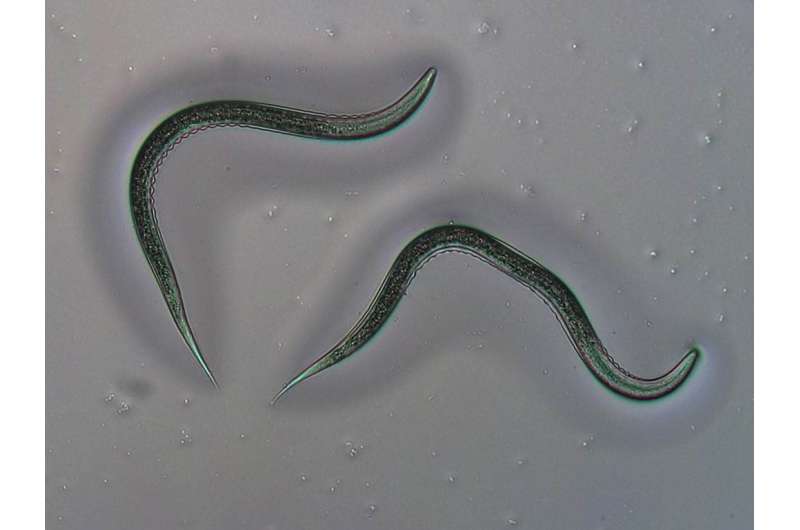How nematodes outsmart the defenses of pests

The western corn rootworm, one of the world's most damaging maize pests, can use plant defense compounds to defend itself against its own natural enemies, so-called entomopathogenic nematodes. However, the nematodes can become immune against these compounds in turn, which enhances their ability to fight the western corn rootworm, as researchers at the University of Bern show. This mechanism may contribute to improving biological pest control.
The western corn rootworm causes economic losses of over 2 billion US dollars in maize cultivation and is thus a serious agricultural pest. Originally from America, the western corn rootworm is currently invading Europe, including Switzerland.
A successful pest
In an earlier study, Christelle Robert and Matthias Erb from the Institute of plant sciences (IPS) at the University of Bern elucidated one of the strategies that underlies the success of the western corn rootworm. Maize plants store certain defense substances, so-called benzoxazinoids, in their roots. These substances are harmful to many pests. However, the western corn rootworm has developed a strategy to detoxify these substances. The larvae of the corn rootworm thus become resistant against the plant's own defense. Even worse—the larvae store the benzoxazinoids in their bodies and in turn, use them for self-defense against their own enemies, including parasitic roundworms (entomopathogenic nematodes). The fact that the western corn rootworm has found a defense strategy against nematodes is of particular importance, as the nematodes are used as biological control agents against this pest.
"Considerable successes have already been achieved in the field using nematodes; efficiency-increasing measures could further boost this approach," explains Matthias Erb, Professor for Biotic Interactions at the IPS. "Against this background, we asked ourselves the question: If pests such as the western corn rootworm can become immune against plant defense substances, could beneficial organisms such as entomopathogenic nematodes do the same?"
Breeding beneficial organisms for pest control
The researchers compared nematodes from areas in which the western corn rootworm is present with nematodes from areas where it is absent. "We found that nematodes from infested areas are resistant against benzoxazinoids, unlike nematodes from other areas," says Xi Zhang, who worked on the project as a Ph.D. student. In the lab, the researchers were able to observe that nematodes which were exposed to the the western corn rootworm became resistant to plant defense substances within just a few generations. "The speed of this adaptation surprised us," says Zhang.
The results of the study, which was published in the journal PNAS, are particularly relevant for biological pest control. "Beneficial insects like nematodes, which are resistant against plant defense substances, can keep the insect pests that accumulate these substances from the plant at bay," explains study co-author Ricardo Machado. This trait can be acquired very quickly through targeted selection and is thus a promising breeding target. "We expect that many other beneficial organisms could be improved by focusing on their capacity to resist plant defense compounds," says Machado.
In the next stage, researchers are targeting the symbiotic bacteria of the nematodes to make them resistant against benzoxazinoids, and to test the improved biological control agents in the field. "This is a next step to bring our research closer to agricultural application," says Machado.
Plant defense compounds shape food chains
In the research project, funded by the Swiss National Science Foundation (SNSF), the researchers relied on a combined approach of behavioral ecology, analytical chemistry and plant genetics. The findings illustrate the importance of plant defense compounds such as benzoxazinoids for the evolution and dynamics of food chains. "The arms race between plants and herbivores is often viewed as a motor of the chemical and biological diversity of these two groups," says study co-author Christelle Robert. "Our study indicates that plant defense compounds may influence the evolution of entire food chains."
As part of the interfaculty research cooperation "One Health" at the University of Bern (see box), the researchers have recently started to investigate how benzoxazinoids affect the health of animals and humans. "The integration of our findings into the central agricultural food chain is a fascinating expansion of our work with a lot of potential," says Matthias Erb.
More information: Xi Zhang et al. Plant defense resistance in natural enemies of a specialist insect herbivore, Proceedings of the National Academy of Sciences (2019). DOI: 10.1073/pnas.1912599116
Journal information: Proceedings of the National Academy of Sciences
Provided by University of Bern



















